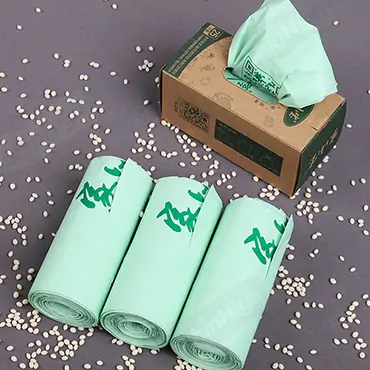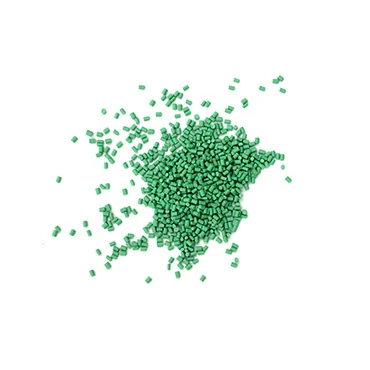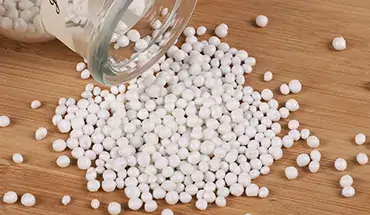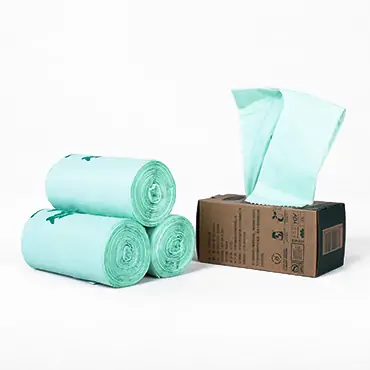We’ve all faced the familiar decision at the supermarket checkout: “Paper or plastic?” Perhaps you utilize reusable bags, reflecting a commitment to sustainability. However, have you thoroughly analyzed which shopping bag option truly offers the greatest benefit, both practically and environmentally?
Today, we’re diving deep into the world of shopping bags at supermarkets. We’ll pit the classic cotton tote against the seemingly eco-friendly paper bag and the often-maligned plastic shopping bag. And, spoiler alert, you might be surprised by what we uncover. As a leading plastic shopping bag manufacturer, we believe in transparency and informed choices. So, let’s unpack this issue.
The Contenders: A Breakdown of Shopping Bag Choices
Each type of shopping bag has a fan club and a set of pros and cons. It’s like choosing a character in a video game – each has its strengths and weaknesses.
Cotton Bags
They’re the poster child for reusability. You see them everywhere, emblazoned with witty slogans and trendy designs. They feel natural, sturdy, and you can toss them in the wash. What’s not to love?
Well, beneath that wholesome exterior lies a bit of a resource hog. Growing cotton requires vast amounts of water and often involves a cocktail of pesticides. Think of it like a high-maintenance celebrity – looks great on the surface but demands a lot behind the scenes.
Paper Bags
They seem like the obvious eco-choice. They’re made from trees, a renewable resource, and they’re biodegradable (sort of). But here’s the rub: turning a mighty oak into a flimsy paper bag takes a serious toll.
We’re talking deforestation, massive energy consumption, and a whole lot of water. Plus, let’s be real, paper bags aren’t exactly known for their durability. One wrong move with a leaky carton of milk, and you’ve got a soggy mess on your hands. Have you tried to carry heavy groceries with paper bags?
Plastic Shopping Bags
The villain of our story, or are they? Traditional plastic shopping bags, often made from polyethylene, are undeniably convenient. They’re strong, lightweight, and waterproof. But their environmental reputation? Let’s just say it’s taken a beating.
However, the plastic bag industry hasn’t been sitting idle. We’ve been innovating, and developing biodegradable and compostable options that break down much faster and leave a smaller environmental footprint. It’s like the plastic bag got a tech upgrade – the same great features, but with a conscience.
Manufacturing Realities: What it Takes to Make Each Bag
Let’s lift the curtain and peek into the factories. How are these bags actually made?
Cotton’s Complex Journey
Growing cotton is a thirsty business. We’re talking about thousands of liters of water just to produce one kilogram of cotton. Then comes the weaving, dyeing, and sewing – each step adding to the environmental cost.
And let’s not forget the pesticides. Cotton crops are notorious for attracting pests, leading to heavy pesticide use. These chemicals can contaminate water sources and harm ecosystems. It’s like that seemingly perfect Instagram photo – a lot of filters and editing went into making it look that good.
Paper’s Path: From Forest to Fragile
Paper bags start their life as trees, and that means logging. While some paper comes from sustainably managed forests, deforestation remains a significant concern. Once the trees are felled, they’re pulped, a process that consumes vast quantities of water and energy.
The resulting paper is then bleached, often using chlorine-based chemicals, and formed into bags. The whole process is like a Rube Goldberg machine – overly complicated and resource-intensive. The shopping bags may bring a bad impact on the ecosystem.
Plastic Production: Efficiency and Evolution
Traditional plastic shopping bags are made primarily from polymers derived from petroleum or natural gas. While these are non-renewable resources, the production process is surprisingly efficient. Think of it as a well-oiled machine – it gets the job done quickly and with minimal waste.
But the real game-changer is the rise of bioplastics. These are made from renewable biomass sources like corn starch or sugarcane. They offer the same benefits as traditional plastics but with a much lower carbon footprint. It’s like switching from a gas-guzzling car to an electric vehicle. We are also developing our technology in this field.
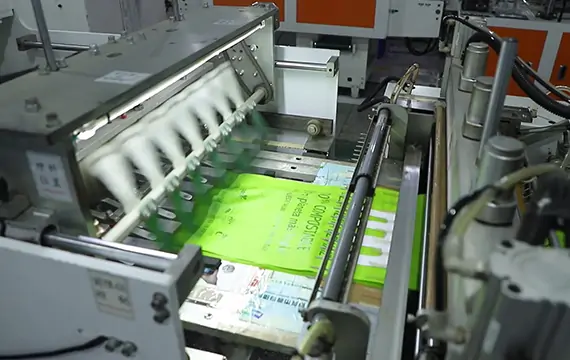
The Supermarket Showdown: Performance in the Real World
Okay, enough about manufacturing. Let’s put these bags to the test where it really matters – in the supermarket aisles.
Cotton’s Carrying Capacity
Cotton bags are strong, no doubt. You can stuff them full of groceries, and they’ll likely hold up. But they’re not exactly waterproof. A sudden downpour or a leaky container can leave you with a damp, stained bag.
And while they’re reusable, they do require washing, which adds to their water consumption. It’s like owning a reusable water bottle but constantly having to refill and wash it.
Paper’s Practicality (or Lack Thereof)
Paper bags are lightweight, which is a plus. But they’re also notoriously fragile. One wrong move, and you’ve got a rip. And forget about using them on a rainy day – they’ll disintegrate faster than a sandcastle in a tsunami.
Plus, they’re not exactly space-saving. Storing a bunch of paper bags can be a bulky affair. It’s like trying to fold a fitted sheet – awkward and never quite right.
Plastic’s Performance Prowess
Plastic shopping bags are the kings of convenience. They’re easy to carry, store, and tear off the roll. They’re waterproof, protecting your groceries from the elements. And they’re surprisingly strong, capable of handling heavy loads without breaking a sweat.
It’s like having a personal assistant who’s always ready to lend a hand – efficient, reliable, and always there when you need them.
The Environmental Elephant in the Room: Sustainability Concerns
Now, let’s address the big one: the environment. Which bag is the most sustainable choice?
Cotton’s Dirty Secret: Environmental Impact Beyond the Bag
We’ve touched on this before, but it bears repeating. Cotton’s environmental footprint is significant. The water usage alone is staggering, and the heavy reliance on pesticides poses a threat to biodiversity and human health.
It’s like that friend who talks a big game about being eco-friendly but secretly drives a gas-guzzling SUV.
Paper’s Problematic Production: Deforestation and Degradation
Paper bags may seem like a greener choice, but their production comes at a cost. Deforestation, energy consumption, and water usage are all major concerns. And while paper is biodegradable, it often ends up in landfills, where it can take years to decompose and release methane, a potent greenhouse gas.
It’s like recycling a plastic bottle but then throwing it in the trash – you’re not really making a difference.
Plastic’s Path to Redemption: Biodegradability and Beyond
The “white pollution” caused by traditional plastic shopping bags is a real issue. These bags can persist in the environment for hundreds of years, polluting our oceans and harming wildlife.
But here’s where the new generation of plastic shopping bags comes in. Biodegradable options, made from plant-based materials or with special additives, break down much faster under specific conditions. Compostable bags go a step further, decomposing into nutrient-rich compost that can be used to fertilize plants.
It’s like the plastic bag industry had an epiphany – realizing its mistakes and striving to do better.
The Business Case for Plastic Shopping Bags
For supermarkets, distributors, and suppliers, the choice of shopping bags isn’t just about environmental responsibility. It’s also about the bottom line.
Cost-Effectiveness: A Win for Retailers and Suppliers
Plastic shopping bags, especially the traditional kind, are incredibly cost-effective to produce. This translates to lower prices for retailers and, ultimately, for consumers. It’s like finding a great deal on your favorite product – everyone wins.
Customization and Branding Opportunities
Plastic shopping bags offer a blank canvas for branding. Supermarkets and retailers can print their logos, slogans, and promotional messages on the bags, turning them into walking advertisements. It’s like wearing your favorite band’s T-shirt – you’re spreading the word wherever you go.
Meeting Consumer Demand for Convenience
Let’s face it, consumers love convenience. Plastic shopping bags are lightweight, easy to carry, and readily available. They’re the ultimate grab-and-go solution for busy shoppers. It’s like having a fast pass at an amusement park – you get to skip the lines and get straight to the fun.
The Rise of Eco-Conscious Consumers: Offering Biodegradable Choices
More and more consumers are becoming environmentally aware. They’re actively seeking out sustainable options, and that includes their choice of shopping bags. By offering biodegradable and compostable plastic bags, businesses can cater to this growing market segment and enhance their brand image.
It’s like a restaurant offering vegetarian and vegan options – you’re catering to a wider range of preferences and showing that you care.
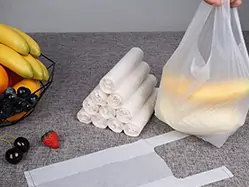
Conclusion
So, which shopping bag is the best to use at the supermarket? The answer, as you’ve probably gathered, is not so simple. Each type of bag has its pros and cons, its environmental baggage (pun intended).
But here’s what we believe: the future of shopping bags lies in responsible innovation within the plastic industry. By embracing biodegradable and compostable options, investing in research and development, and educating consumers about the choices available, we can create a more sustainable future.
We, as a leading compostable bag manufacturer, are committed to this vision. We’re constantly exploring new materials, technologies, and ways to reduce our environmental impact. And we’re partnering with distributors, suppliers, and supermarkets to make these options more widely available.
So, the next time you’re at the supermarket checkout, take a moment to consider your choices. And remember, the humble plastic shopping bag might just be a more sustainable option than you think – especially when it’s made with the future in mind. Let’s work together to bag a better future, one responsible choice at a time.

